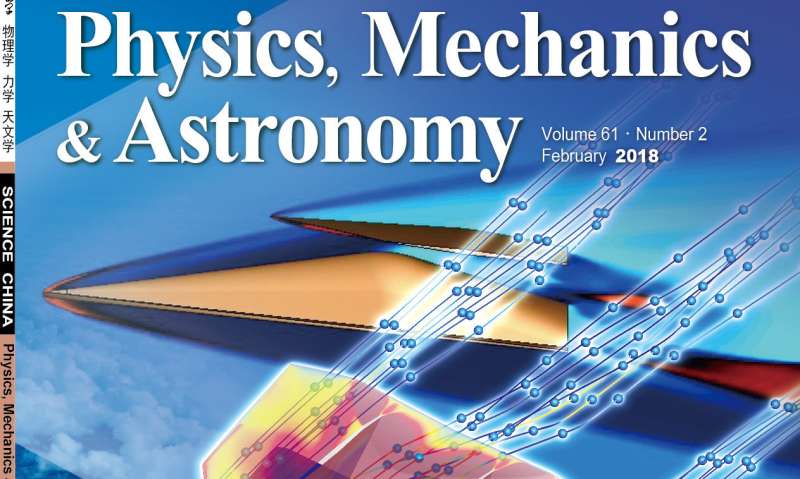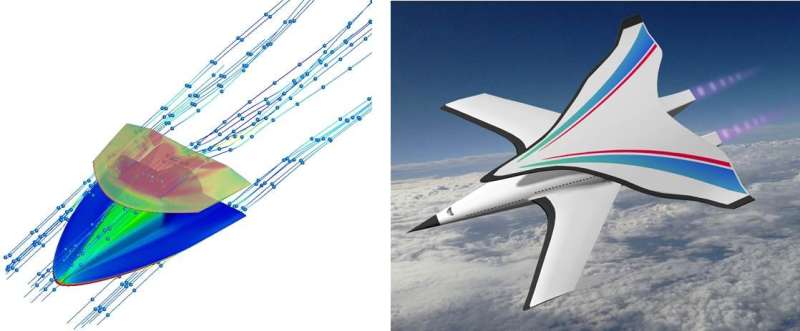A new family of aerodynamic configurations for hypersonic airplanes

Hypersonic vehicles, which fly at Mach values larger than five (flight velocity more than 6000 km/h), could provide more convenient and efficient transportation than present subsonic airplanes for long-distance journeys in future. Typically, it only takes a couple of hours to fly from Beijing to New York at hypersonic speeds. Recent interest in these vehicles has grown, and various innovative designs have been proposed and studied.
Despite entering the age of hypersonic flight, there still exist many problems to resolve. How to design an advanced aerodynamic configuration is one of them. Prof. Kai Cui, Dr. Yao Xiao, Dr. Ying-Zhou Xu, and Dr. Guang-Li Li from the Chinese Academy of Sciences have been studying this problem. After more than seven years of investigation, they first proposed a family of innovative hypersonic "I-shaped" aerodynamic configurations. Their work was published as the cover article of SCIENCE CHINA Â鶹ÒùÔºics, Mechanics & Astronomy.
In general, there are at least three objectives in designing an aerodynamic configuration: the high lift-to-drag ratio (L/D), the high volumetric efficiency, and the high lift coefficient. Designers always consider the high L/D during the cruise state as the primary goal because the flight range is linearly proportional to the L/D, according to the famous Breguet equation. In addition, a vehicle should provide sufficient space to contain equipment, passengers and cargo. Furthermore, the aerodynamic lift coefficient should be enhanced in whatever way possible. This is because a vehicle with high lift may elevate the vehicle to a high altitude where the aero-thermal environment is improved, owing to the low atmosphere density.
Unfortunately, it is difficult to obtain a high L/D for a generic configuration due to the presence of strong shock wave drag and massive viscosity in the hypersonic regime. Moreover, there exist strong contradictions among the L/D, the volumetric efficiency and the lift coefficient. Among the existing configurations, the waverider has been deemed the most promising because the containment of flow beneath the vehicle results in a high pressure exerted on the lower surface. Yet a pure waverider with high L/D is always too thin to provide enough volume for fuel and payloads. Typically, the volumetric efficiency of the viscous optimized waverider is lower than 0.12. Although the freestream upper surface of a pure waverider can be morphed to an upwarp to enlarge the volume, this canopy actually forms a compression surface on the upper part of the vehicle, which leads to an increase in both the aerodynamic drag and the negative lift, causing an overall reduction in L/D.

To enhance the aerodynamic performance of hypersonic aircraft with large volume requirements, a new concept called a "high-pressure capturing wing" (HCW) was first proposed by Kai Cui, et al. Unlike generic configurations, an extra wing called the HCW is attached to the top of an upwarp airframe. Based on the shockwave compression theory, the high-pressure airflow compressed by the upper surface of the vehicle acts on the HCW when it flies in the hypersonic regime. Therefore, the aerodynamic lift significantly augments on the vehicle with only a small increase in drag, producing a correspondingly high increase in its L/D. Furthermore, such a concept particularly fits for vehicles with large volumes because the lift produced by the HCW increases with the increase of the compression angle in the upwarp.
Expanding on the philosophy of HCWs, a family of novel configurations is proposed in this letter. There are two lift surfaces in this configuration. The lower surface is a common compression surface, while the upper one is designed according to the idea of HCWs. The parts between the two wings are the airframe and the attachment struts. Because the cross-section of the configuration appears like the letter "I," it is thus called the hypersonic I-shaped aerodynamic configuration (HIAC).
In order to validate the advantages of HIACs, a test model with the volumetric efficiency 0.175 was generated as a typical example. Moreover, the leading-edge profiles of both the low wing and the HCW were optimized by combined using the computational fluid dynamics, the design of experiments method, the surrogate models method, and the genetic algorithm. Subsequently, a numerical simulation work was carried out to evaluate the aerodynamic performances of the model. The results show that both the L/D and the lift coefficient drastically improve benefiting from the innovative configuration. The maximal L/D values at Mach 5 to 7 are more than 4.5, while the increased percentages of corresponding values of the lift coefficient are about 60 percent comparing with generic configurations.
In the present study, only the profiles of the leading edges were taken as design variables of the optimization. The aerodynamic performance of the configuration may be further enhanced if the surface shape of the HCW is considered as optimization variables. The authors believe their present study will promote further research in the aerodynamic design of high-speed configurations, which may ultimately offer a new candidate for hypersonic flight vehicles.
More information: Kai Cui et al, Hypersonic I-shaped aerodynamic configurations, Science China Â鶹ÒùÔºics, Mechanics & Astronomy (2017).
Provided by Science China Press




















